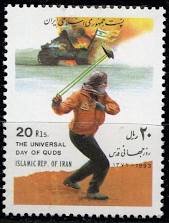The first stamp, from Iran, was released in Iran for Al Quds Day, during the First Intifada. Intifada is an Arabic word literally meaning, as a noun, "tremor", "shivering", "shuddering". It is derived from an Arabic term nafada meaning "to shake", "shake off", "get rid of". In contemporary Arabic usage, an intifada is a rebellion or uprising, or a resistance movement referring to a legitimate uprising against oppression.
The First Intifada began on the 9th December, 1987. The day before, a driver of a huge truck was driving north on the Gaza highway and allegedly swerved his semi-trailer into the oncoming traffic at the Erez Checkpoint fuel station. The resulting crash involved a car and a truck, both were taking Arab workers back to their homes. 4 Arabs were killed and ten wounded. Rumors circulated that the driver intended to kill Arabs following the death earlier of Shlomo Sakal, an Israeli victim of a terrorist attack. Bocovza denied this claiming that he was trying to turn into the fuel station. The following day riots broke out at the funeral of one of the victims. During the riot, one Arab was killed and many others wounded. As a result, the riots quickly spread throughout Gaza and the West Bank.
What is Al Quds Day, you ask? Well, the Ayatollah Khomeini announced that the last Friday in the month of Ramadan would be recognized as the Day Calling for the Liberation of Jerusalem from the little Satan, that is, Israel.
What can you see in the stamp, an Arab, probably a young man because that's how they sold the Intifada to the world, standing in front of an Israeli tank. You can see the Israeli flag hoisted on the tank. This young man was throwing a stone using a slingshot. Somehow the tank caught fire from the stones.
This Intifada was called the Stone Intifada. The Second Intifada was the Al Aksa Intifada and the Third Intifada was Knives Intifada. It must be clear to everyone that the stone did not cause the tank to catch fire.
The second stamp was issued by Iraq for the Second Intifada, called the Al Aksa Intifada , and the Iraqis called it the Liberation Uprising. This intifada began following Prime Minister Ehud Barak to PLO leader Yassir Arafat and Arafat's refusal to accept it.
Now what can you see in the stamp? Once again we an Arab, but this time it is clear that he is a young man and he is throwing a stone in the direction of a tank, this time without the slingshot. What damage the stone would have done to the tank, I do not know.
What is missing in the stamp? The Al-Aqsa Mosque! The stamp instead shows the Omar Mosque, i.e. the Dome of the Rock. And why? Because with all due respect to the "holiness" of the Al Aqsa Mosque, it is not very eye-catching.
The third stamp completes this short story, and was also issued for the Al Aqsa Intifada. It is a beautiful and very eye catching stamp. A young Arab boy throws a stone at a tank but there is also the Omar Mosque (not al-Aqsa) and a barbed wire fence. The barbed wire fence for Jerusalem is a typical motif in Arab stamps depicting Jerusalem, but this is the first time seen in a stamp from Oman.
The stamp is in black, meaning the color of death. Blood dripping from above. Here the Al Aqsa Intifada is clearly stated. In terms of propaganda I mentioned this in an earlier blog.
So what do they have in common and it is not accidental apart from the fact that they were issued for Intifadas? The Arab propaganda movement wanted to show themselves as the David in front of the Jewish Goliath and they wanted to draw your attention to the equality of their struggle to the struggle of the student in China in Tinaman Square who stood in front of a tank and did not move.











No comments:
Post a Comment